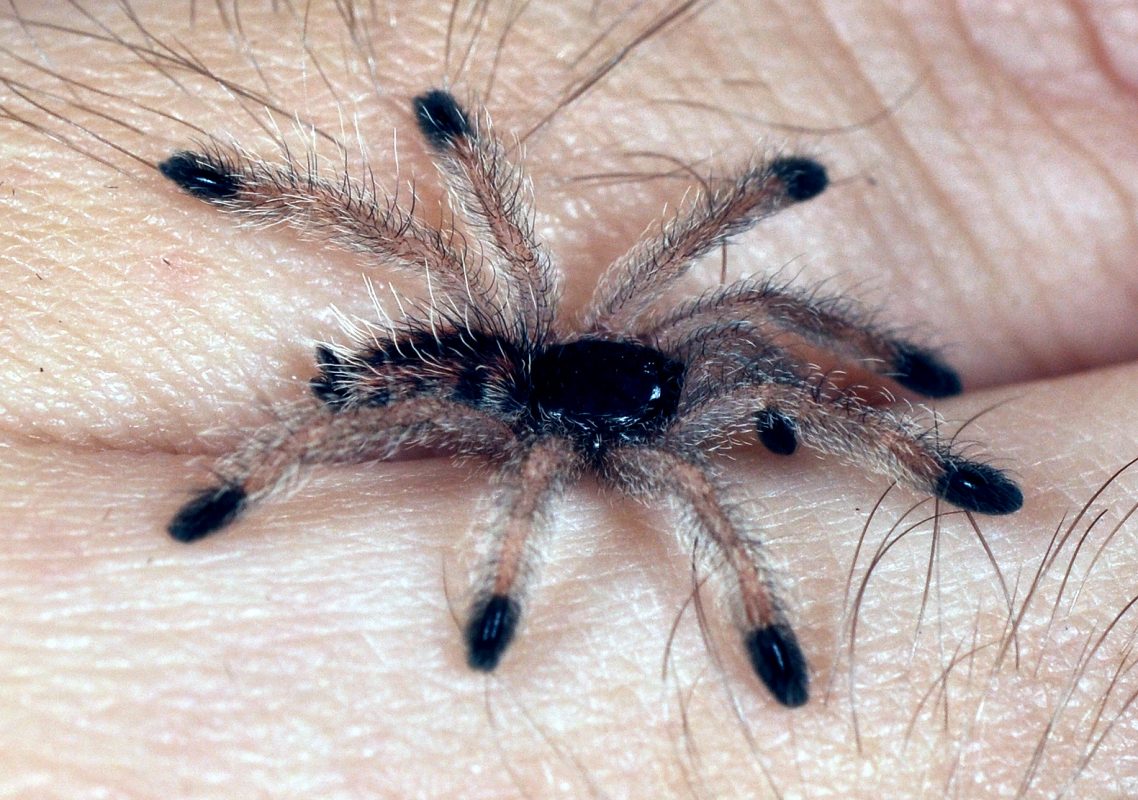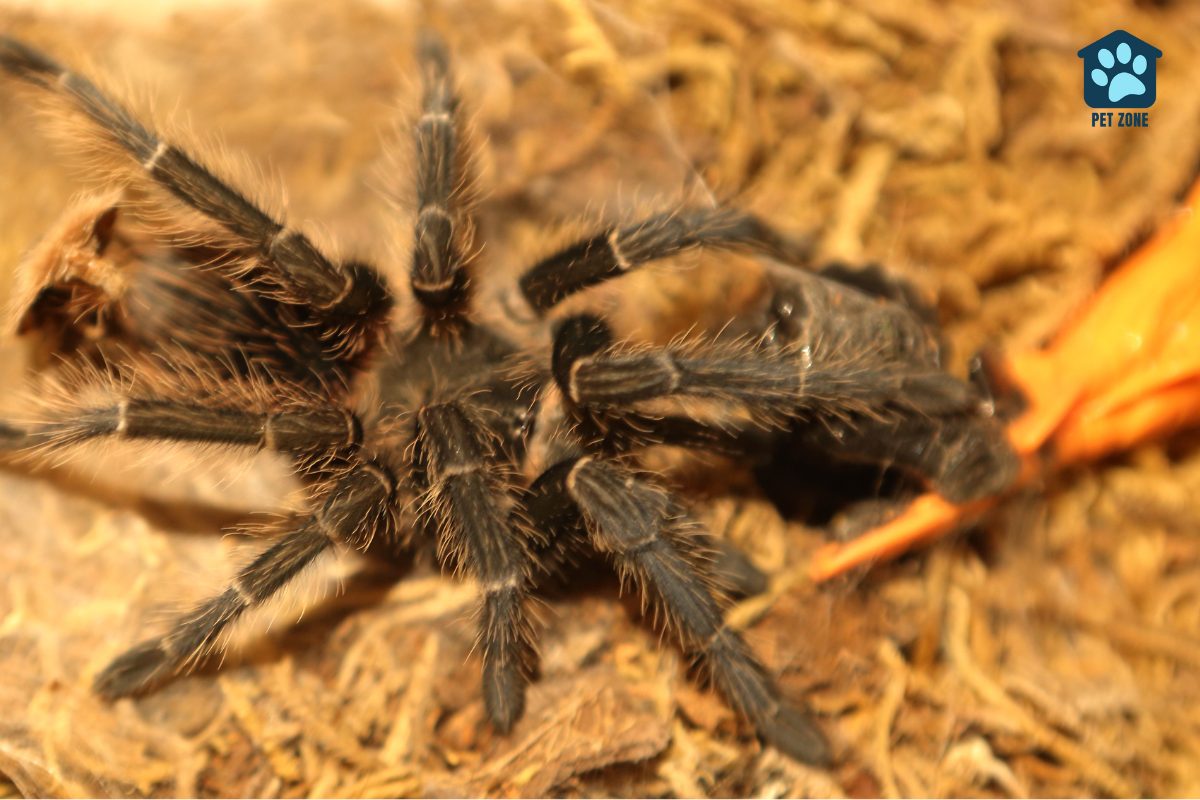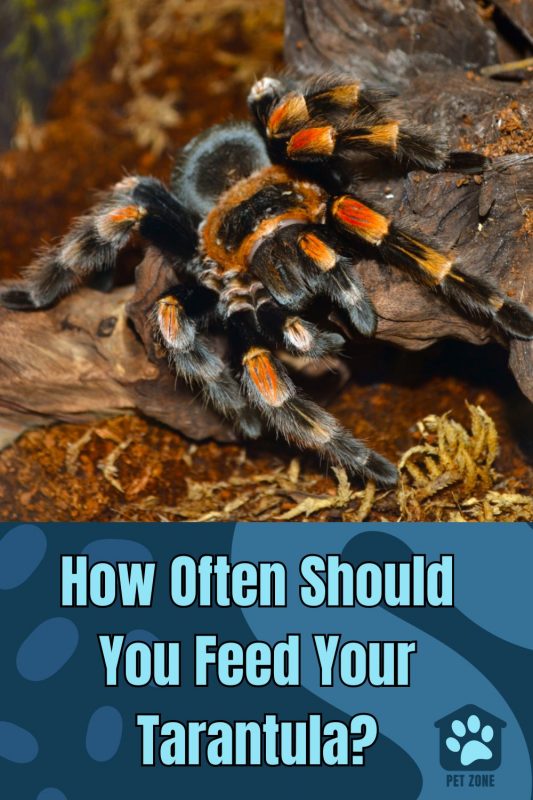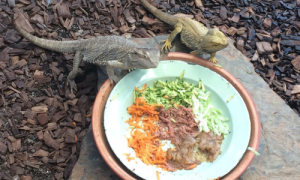Estimated reading time: 11 minutes
Are you the proud owner of a fuzzy, eight-legged, big spider friend and find yourself puzzled about how often you should be filling their dinner plate?
Whether you’ve just welcomed a tiny tarantula sling into your home or are watching over an adult that seems to rule its enclosure with majestic calm, figuring out the right feeding frequency can sometimes feel like solving a mystery.
Here’s an intriguing fact: While wild tarantulas might hunt for food every couple of days, those cozy in captivity need a more tailored approach to dining.
This article will unravel this enigma with tips to help ensure your pet spider thrives. We’ll cover everything from the type and size of prey to recognizing when your tarantula isn’t hungry.
Key Takeaways
- Slings, or baby tarantulas, should eat every 2 to 3 days; adults eat less often, usually once a week or less.
- Feed your tarantula different insects like crickets and worms for a healthy diet.
- Watch your tarantula’s behavior to know when it’s hungry or ready to molt.
- Always use tongs to put food in the enclosure and take out any uneaten insects after 24 hours.
- If your tarantula isn’t eating, it could be normal fasting but see a vet if you’re worried.
Understanding Tarantula Feeding
Tarantula owners often wonder if their pets are hungry because these creatures act differently than other animals during feeding times.
Here’s what you need to know about tarantula feeding—these spiders have an internal clock that tells them when it’s time to eat.

They’ll hunt for food more actively when they’re ready for a meal. You might see your tarantula pacing its enclosure or being more alert when prey is nearby. This behavior signals that it’s a good time to drop in a cricket or worm.
But watch out before and after a molt—their skin will be soft, so no meals until their new exoskeleton hardens up! Remembering this will help keep your eight-legged friend healthy and happy.
Frequency of Feeding
Tarantulas have different feeding schedules depending on their life stage. Slings (baby tarantulas) typically need to be fed more frequently than juvenile and adult tarantulas. It’s important to understand the specific needs of your tarantula at each stage of its development to establish a suitable feeding schedule.
When determining how often to feed adult tarantulas, it’s important to take into account the specific species. A fully grown Grammostola, for example, only requires four or five crickets per month for optimal health.
On the other hand, an adult Therophosa or Pamphobeteus species would consume that amount in a single meal and should be fed a few times a week.
Feeding schedules for slings (baby tarantulas)
Baby tarantulas, also known as slings, need the right amount of food to grow strong. Here’s how to keep your little spider healthy with a good feeding schedule.
- Slings are fragile and should be fed 2 to 3 times per week due to frequent molting.
- Choose small feeder insects, like pinhead crickets or flightless fruit flies.
- The prey should be slightly smaller than the length of your sling for easy eating.
- This helps them grow faster but watch out not to overfeed them.
- The type of insect you offer will depend on what kind of tarantula you have.
- Always check how much your sling eats and grows.
- If they stop eating or seem full, they might be ready to molt soon.
Feeding schedules for juvenile and adult tarantulas
Taking care of your tarantula means knowing how often they need to eat. Juvenile and adult tarantulas have different feeding needs.
- Juvenile tarantulas (around 1.5 to 2 inches in size) thrive on a feeding schedule of once or twice per week.
- Larger juvenile tarantulas do well with feedings every 7 – 10 days, giving their bodies time to digest properly.
- Adult tarantulas can go longer without food. Feed them once a week or sometimes less if they’re not showing hunger signs.
- For adults, one big prey item like a large cricket will suffice for their weekly meal. This mimics their wild hunting success.
- Tarantula sizes matter when it comes to food portions. Make sure the insects are appropriately sized for your spider friend.
- Pay attention to your pet’s appetite fluctuations. Adult tarantulas might eat more in warmer temperatures when their metabolism is higher.
- Hunger cues from your spider are key—offer food if you notice active hunting behavior or an empty burrow.

What to Feed Your Tarantula
When it comes to feeding your tarantula, it’s important to vary their diet with a selection of feeder insects. This can include mealworms, superworms, crickets, cockroaches, and even small earthworms for larger tarantulas.
Types of feeder insects
To ensure your tarantula gets a balanced diet, consider the following feeder insects:
- Crickets: These are a popular choice and provide good nutrition for your tarantula. They can be easily obtained from pet stores and are generally well-received by tarantulas.
- Mealworms: A nutritious option that can be fed to your tarantula. They are high in protein and can be readily found at pet stores.
- Waxworms: Considered highly nutritious, waxworms are a great option to vary your tarantula’s diet due to their rich nutritional content.
- Roaches: Dubia roaches or discoid roaches are other options that offer a diverse nutrient profile for your tarantula’s diet.
- Superworms: Larger than mealworms, superworms provide ample nutrition and are generally accepted by tarantulas.
- Red Runners: These small roaches can be another source of diversity in your tarantula’s diet, offering different nutrients compared to crickets or mealworms.
The role of variety in a tarantula’s diet
Offer your tarantula various insects to ensure they receive essential nutrients. Include feeder insects like roaches, crickets, mealworms, superworms, and hornworms in their diet. Purpose-bred feeder insects can provide a balanced intake of protein and nutrients for your pet.
The Size and Quantity of Feeds
When feeding your tarantula, it’s essential to consider the appropriate size of feeders for different tarantula sizes and how many insects to feed at a time. This will help ensure that your tarantula is getting the right amount of food without overwhelming them or causing any issues with digestion.
Appropriate size feeders for different tarantula sizes
For smaller tarantulas, like slings under 2 inches, choose appropriately sized feeders. Larger prey could harm these fragile spiders. Juveniles over 2 inches may handle larger insects, but still avoid oversized feeders to prevent injury.
To ensure your tarantula’s safety and comfort during feeding, be mindful of the size of the prey you offer. By adhering to these guidelines, you can help your pet maintain a healthy diet while minimizing potential risks associated with feeding.
How many insects to feed at a time
Tarantulas in captivity are generally fed one appropriately sized feeder insect at a time. Spiderlings may be fed 2-3 times per week, while older tarantulas may only be fed once per week or less.
Varying the prey size can help stimulate their natural hunting behaviors and provide them with the right amount of nutrition. Understanding your tarantula’s feeding habits is essential for maintaining its health and well-being.
When it comes to feeding your tarantula, remember that spiderlings have different needs than adult tarantulas. Ensure you’re providing the right portion sizes based on their age and size to keep them healthy and happy.
How to Serve Your Tarantula’s Meal
Serve your tarantula’s meal by safely handling feeder insects and ensuring your tarantula’s comfort during feeding. It’s essential to remove any uneaten prey after a few hours to maintain the cleanliness of the enclosure and prevent any harm to your pet.
Safe handling of feeder insects
When handling feeder insects for your tarantula, ensure they are appropriately sized to avoid causing harm to your pet.
Use tongs or forceps to pick up the insects and place them into the tarantula’s enclosure. Avoid using your hands as this can stress both the insect and the tarantula, leading to potential injuries.
Always remove uneaten insects within 24 hours to maintain a clean environment and prevent any harm that may be caused by stressed or agitated prey.
Remember not to overcrowd the tarantula’s enclosure with too many feeder insects at once as this can lead to unnecessary stress for your pet. Providing a safe and stress-free environment during feeding will help promote healthy feeding habits and overall well-being for your tarantula.
Ensuring your tarantula’s comfort during feeding
Ensure your tarantula’s comfort during feeding by placing the prey near its hiding spot – this reduces stress and allows for natural hunting behavior. Check that uneaten prey is removed promptly to avoid potential harm to your tarantula.
Consider the age and species of your tarantula when choosing feeder insects, making sure they are appropriately sized for easy consumption, and promoting healthy eating habits.
What to do if Your Tarantula Doesn’t Eat
If your tarantula doesn’t eat, don’t panic. Fasting periods are common in tarantulas, especially before molting. Keep an eye on their behavior and only seek veterinary advice if you notice any concerning signs.
Understanding fasting periods in tarantulas
Tarantulas may go through fasting periods, not to worry. Elderly tarantulas might only need feeding once every 2-3 weeks. And young juvenile tarantulas should be fed at most twice a week for faster growth.
During fasting periods, some tarantulas may not eat for extended periods – this is normal behavior and not a cause for alarm. Young juveniles require more frequent meals, while elderly individuals can go longer between feedings.
Understanding these natural fasting patterns is essential in ensuring the well-being of your pet tarantula.
When to seek veterinary advice
If your tarantula has stopped eating for an extended period, it is crucial to seek veterinary advice promptly. This could be a sign of an underlying health issue that needs professional attention.
Monitoring your tarantula’s feeding schedule and seeking help if they refuse to eat are important steps in ensuring their well-being as pet owners.

The Importance of a Feeding Schedule
Regular feeding is crucial for the health and longevity of your tarantula. A consistent feeding schedule helps maintain their energy levels and overall well-being, so it’s important to establish and stick to a routine for feeding your pet tarantula.
The role of regular feeding in tarantula health and longevity
Regular feeding plays a vital role in maintaining the health and longevity of your tarantula. It’s important to monitor its appetite and adjust the feeding schedule according to its individual needs.
While older tarantulas may require less frequent feeding, younger ones typically benefit from being fed a few times a week. Following a general rule of thumb, most tarantulas thrive on being fed once every one or two weeks, ensuring they receive sufficient nutrition without overfeeding.
Feeding your tarantula regularly not only sustains their well-being but also aids in preventing fasting periods that may occur naturally. By understanding your pet’s specific requirements and adapting their feeding schedule accordingly, you can provide them with optimal care for a healthy and happy life.
Tips for creating and maintaining a feeding schedule
- Consider the age and size of your tarantula to determine the appropriate feeding frequency.
- Monitor your tarantula’s appetite and adjust the feeding schedule accordingly based on their activity level and response to feedings.
- Take into account variations in individual tarantula appetites when establishing a regular feeding routine.
- Factor in temperature and humidity levels, as they can influence how often your tarantula needs to eat.
- Keep track of when your tarantula molts, as they may refuse food before and after molting. Adjust their feeding schedule accordingly.
- Ensure that the prey offered matches the size of your tarantula – offering appropriately sized feeders is crucial for their safety.
- Observe wild tarantulas’ eating habits to gain insight into how often they need to be fed in captivity.
- Seek advice from a veterinarian if your tarantula shows extended periods of fasting or decreased appetite despite adjusting the feeding schedule.
Conclusion
In conclusion, feeding your tarantula requires attention to its growth stage and appetite. Follow a regular feeding schedule based on the age and size of your tarantula. This practical approach ensures their health and longevity.
By monitoring their behavior, you can adjust the feeding frequency as needed. Remember, providing the right prey in appropriate amounts is key to keeping your pet satisfied and healthy.
Frequently Asked Questions
Give your tarantula one appropriately-sized cricket or insect per feeding. It’s best not to overfeed them, as they eat until full, and large prey can be harmful.
For young tarantulas, known as slings, you should feed smaller prey like tiny crickets twice or three times per week. They grow quickly and need more frequent meals.
While power feeding can speed up growth, it’s not the healthiest choice for your spider, and could potentially shorten its lifespan.
Tarantulas may refuse food due to premolt or other reasons. If yours doesn’t eat, remove uneaten insects and try again in a week.
Yes – species like the Mexican Red Knee might munch on fewer crickets a month compared to others that scavenge when given the chance.
Absolutely! Adults tend to chow down less often with larger meals while babies need frequent feeds of smaller critters to help them grow into healthy adults.
As an Amazon Associate I earn from qualifying purchases.










I don’t have a tarantula, nor do I plan on getting one but I have to admit it was quite interesting to read this.
Haven’t had a tarantula for a pet, but this post is insightful. There are such interesting questions you answer.